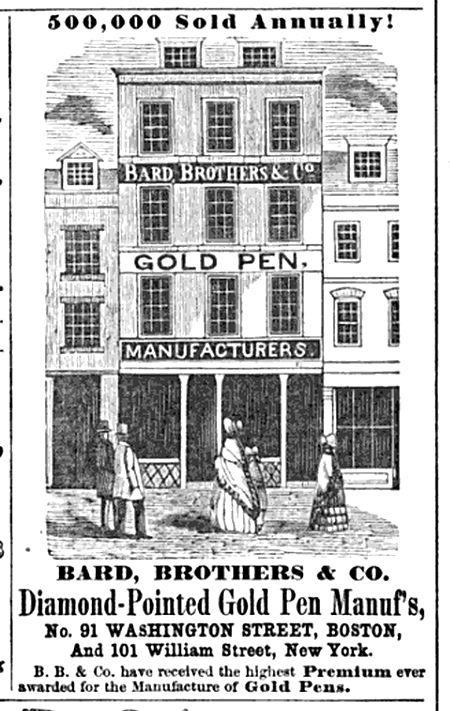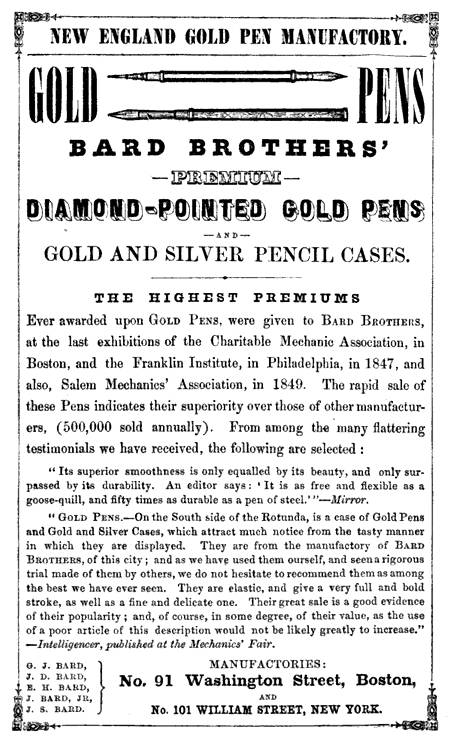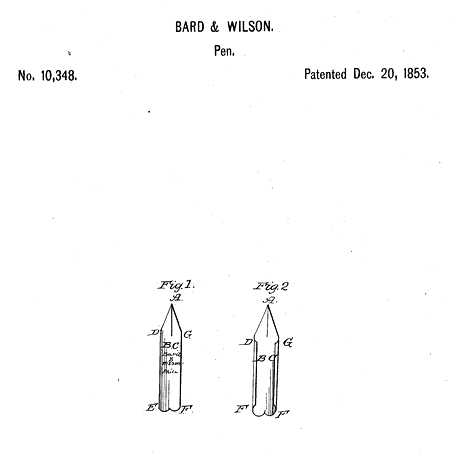Edmund Howe Bard
- Born: Abt 1815, Brooklyn CT
General notes:
Manufacturer
Events in his life were:
- Partnership: James D., Jonathan S., and George J. Bard, circa 1840-1870, in New York City NY. As BARD BROTHERS, gold pen manufacturers with a shop at 101 Williams Street and a factory at the corner of Front and Pearl.

- Advertised: Boston City Directory, in 1850.

- Advertised: Massachusetts State Record and Yearbook, in 1850.
- Partnership: Henry H. Wilson, circa 1853, in Philadelphia PA. As BARD & WILSON.

- He was issued patent number 10,348 on 20 Dec 1853
EDMUND H. BARD AND HENRY H. WILSON, OF PHILADELPHIA, PENNSYLVANIA.
GOLD PEN.
Specification of Letters Patent No. 10,348, dated December 20, 1853; Antedated July 14, 1853.
To all whom it may concern:
Be it known that we, Edmund H. Bard and Henry H. Wilson, copartners under the firm of Bard & Wilson, of Philadelphia, in the county of Philadelphia, State of Pennsylvania, have invented an Improvement in the Construction of Gold Pens; and we do hereby declare that the following is a full and exact description thereof, reference being had to the accompanying drawing and the letters of reference marked thereon.
The nature of our invention consists in the combination of the point commonly called the French point, (which is made by compressing the sides thereof into planes, inclined angularly) and the ordinary cylindrical barrel whereby the pen in being used has all the advantages of the lateral action of the one, and can be inserted in the ordinary penholder as in the other.
To enable others to make and use our invention we proceed to describe its construction and operation.
After the pen is cut out in the rough into the desired shape, it is placed in a die the sides of which, from the shoulder to the point, are planes inclined so as to form an obtuse angle with each other, while the other portion of the die retains the ordinary cylindrical form, which causes the pen to assume the form aforesaid, as is shown in the accompanying drawings.
Figure 1, representing the convex, and Fig. 2, the concave surface of the pen. The points and sides from A, to B, and from A, to C, being inclined planes, meeting and having their apex at the split. The barrel D, E, F, G, being semi-cylindrical in shape.
We are aware that pens have been heretofore constructed in which a portion of the metal has been filed away from the sides of the nib so as to give elasticity to the pen by a diminished thickness of metal. Although the -external surface of the sides of the nib so filed presents somewhat the appearance of two planes, yet the inner surface of the nibs preserves its, cylindrical shape. The elasticity of such pens is due to the reduced thickness of the metal at the part filed and is not due to the divergence of the angular planes forming the sides of the nub during the action of writing. Such pens are inferior to the pens invented by us in elasticity and durability. Being of unequal thickness of metal they are apt to break at the part where the metalis filed down.
Our pens on the contrary are of uniform thickness, are made by the single action of the dies, without any subsequent filing and owe their elasticity solely to the action of the angular planes forming the sides of the nib.
Having thus described our improvement, Ave do not desire to claim the employment of flat nibs when composed of two pieces, as such pens have been heretofore made; but
What we claim, and desire to secure by Letters Patent, isó
The construction of metallic pens having the form of the semicylindrical barrel combined with the angular diverging planes, by compressing the metal between correspondingly shaped dies substantially in the manner hereinbefore described.
Edmund H. Bard
H. H. Wilson
Witnesses:
C. W. Henry
John B. Gest
|





